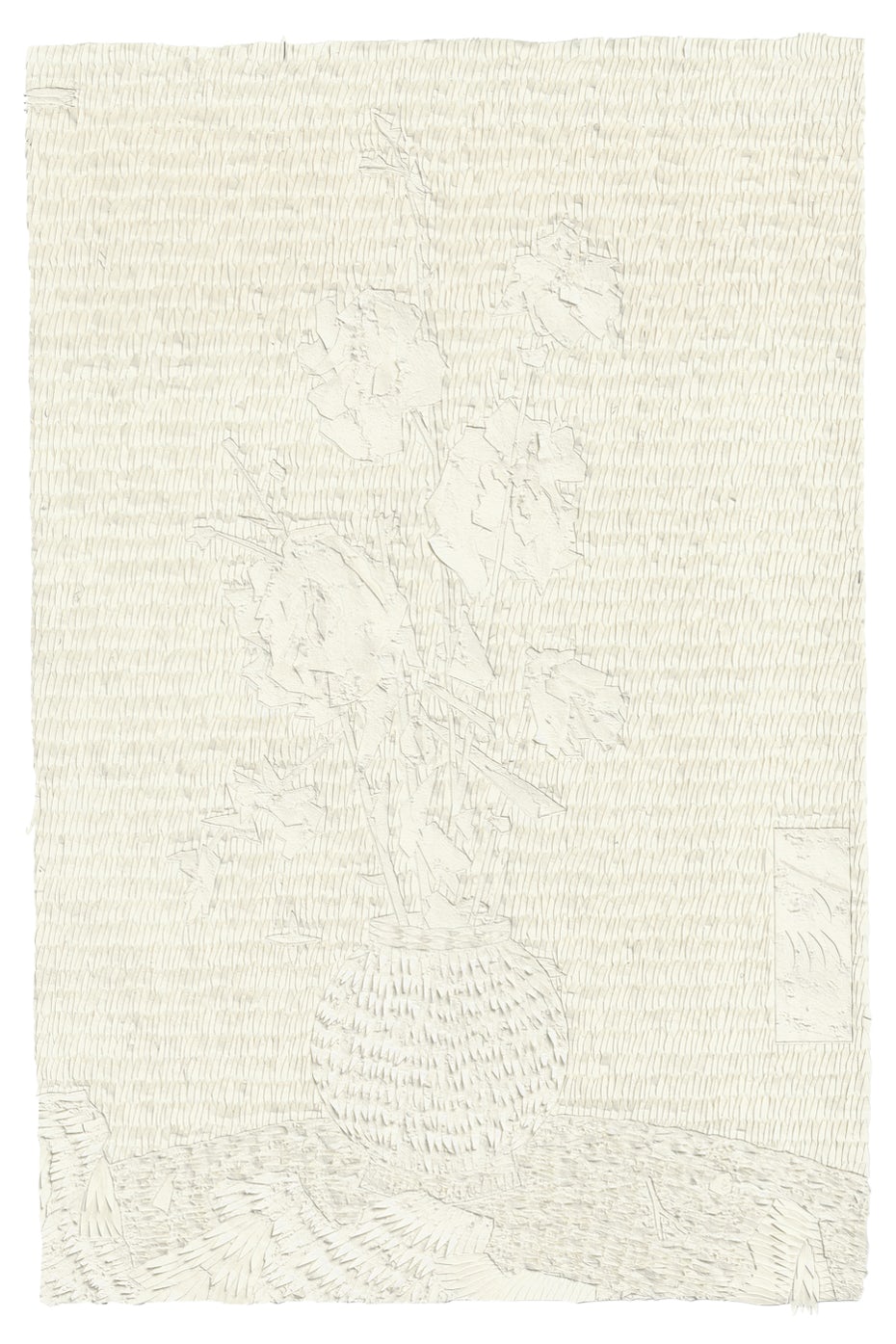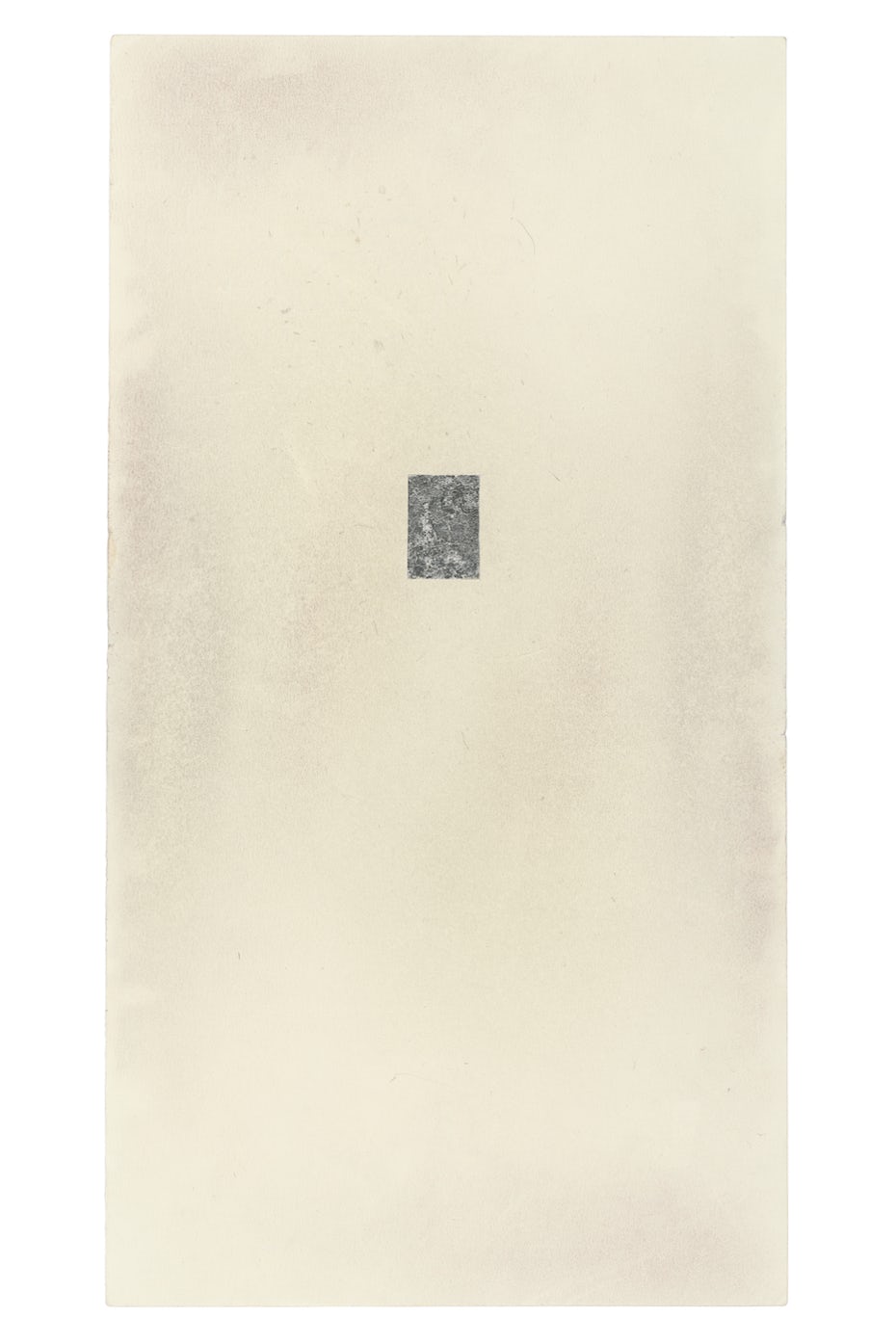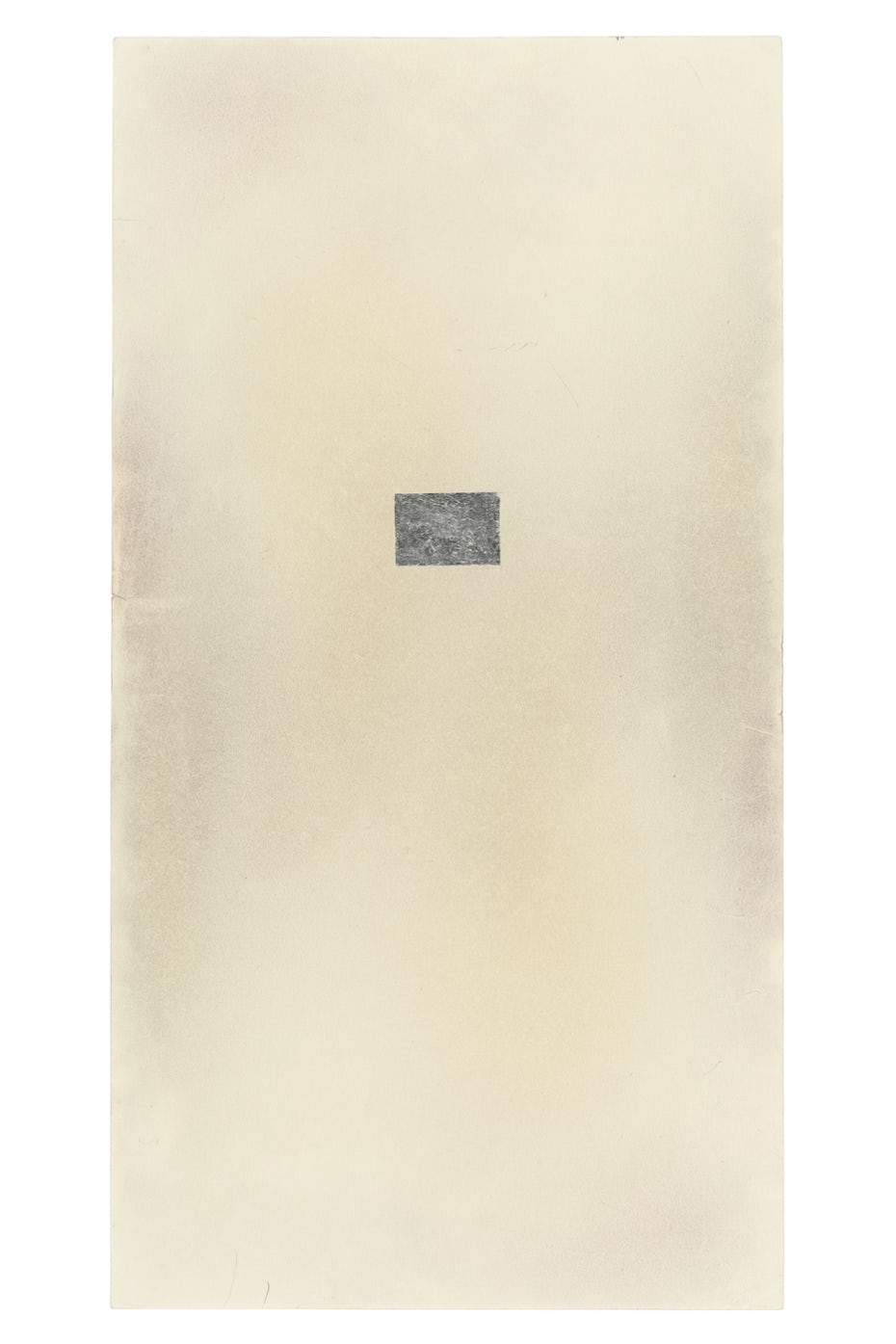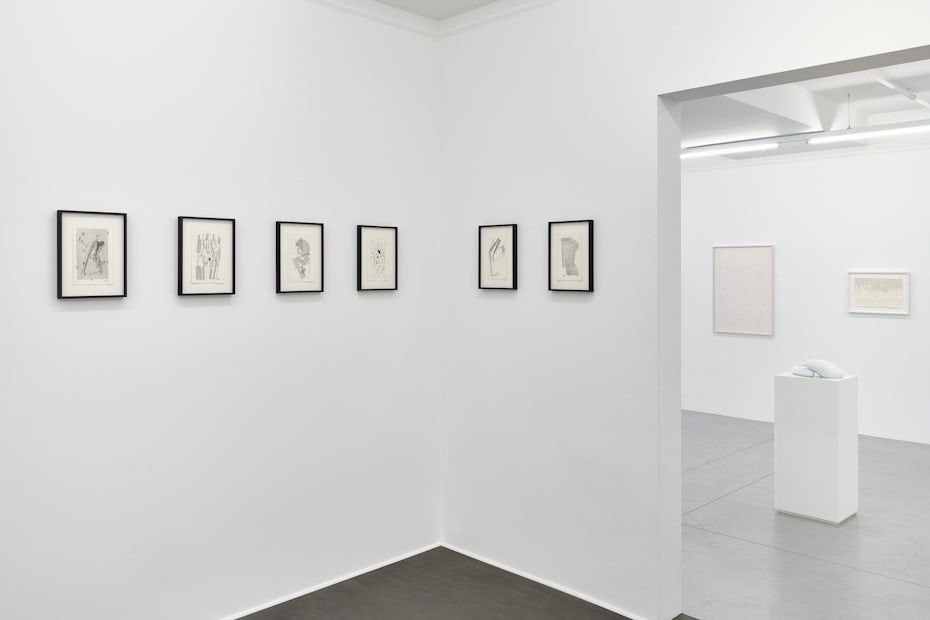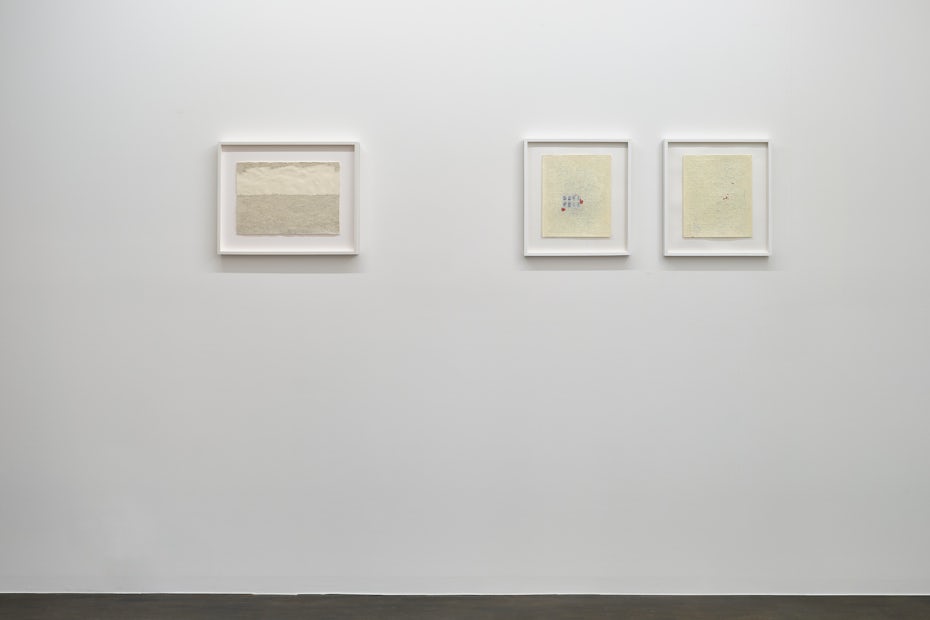Silent Messages – Fabrice Souvereyns in dialogue
Fabrice Souvereyns
Brussels
10.03 - 27.04.2024
Works
Installation views
Press release
Silent Messages – Fabrice Souvereyns in dialogue with Jonathan Callan, Dominique De Beir, Oskar Holweck, Katharina Hinsberg, Bart Stolle, Annick Tapernoux.
Hopstreet Gallery is pleased to announce its upcoming exhibition, ‘Silent Messages’.
The gallery and Fabrice Souvereyns invited six artists whose work engages in a dialogue with Souvereyns’ new work.
Fabrice Souvereyns (°1995 lives and works in Ghent)
For the drawings Souvereyns uses numerous recurring starting points. He opts for Simili Japon paper.
A pencil, eraser and cutter are his only tools. The pencil touches the paper with varying degrees of force, from hard to soft; the lines hover between fragile and deep indentations.
Without a story or theme, he spontaneously investigates with flowing lines in an initial phase. While in the studio, he visually and mentally immerses himself in nature, as if he were among the plants. How exactly does the bark of a tree trunk or the surface of a stone look in his mind? What role do light and shadow play? How do all the elements of nature function together? His field of vision covers the enormity of the cosmos down to the smallest detail of a plant, with every dimension in between. Science informs us that there is much more to learn about nature beyond our limits of observation. The abstract components in his work actually refer to realities that reach beyond our naked eye, though they traverse the recognizable world and make it possible. I’m not only talking about floral genetics.
Occasionally he uses collages and negative shapes. A rhythm evokes syncopation; he answers a previous intervention with a countermovement. Bright areas become dark, and vice versa. The artist consciously deviates from obvious virtuosity. Sometimes he steps back. Fragments are erased. Geometric shapes insert order into the loose lines. The focus areas change along the way; the subject transforms. As the work process evolves, he consciously steers the drawing in a particular direction.
Jonathan Callan’s (°1961 lives and works in London) work ranges across a diverse set of mediums, methods and materials. It is linked by a preoccupation with the limitations of language. Callan often works with texts, books, maps, and photographs. Much of this information is sourced and filtered from secondhand books. He regards his own culture as one that is predominately literary and has had an almost lifelong concern in trying to reconcile his own deep interest in materiality with that pervasive literary history. The work is often playful and self-consciously renders and re-presents much of what might be considered abstract- thought, meaning, understanding- in very physical terms. Texts and images are abraded, removed, reconstituted and at times almost obliterated. The work can be both small and intimate and also expansive, sculptural installations that occupy whole spaces.
Dominique De Beir (b. 1964, female, lives and works between Paris and Picardië) perforates paper, cardboard and polystyrene. She challenged the vocabulary of painting (material, medium and colour) and replaced it with the randomness of gestures and their impact on a surface. This allows her to focus on concepts like scratching and digging, between surface and depth, while exploring physical impact and rhythm. By sometimes pushing perforation to the limits of what the material can handle, she plays with an inherent ambiguity between building and destroying, opacity and transparency, durability and fragility.
Dominique De Beir’s work is characterized by the mise en abyme of a repeated gesture of perforation. The questioning here is of a painterly nature. The gesture is performed on flat media, usually poor and neutral materials such as paper, wax or white cardboard, and sometimes through sheets of carbon paper that leave irregular bluish shadows on the surface.
Katharina Hinsberg’s (°1967 lives and works in Dusseldorf) drawing-based practice is one of today’s most innovative. Hinsberg explores real space and leaf space in equal measure. She questions the concept of drawing and enriches it with many dimensions. The slow, concentrated cutting, releasing of lines plays just as great a role in her work as the usually fast, gestural, often body-related drawing process. In cutting, exposing or piercing, she opens the sheet into space and questions her own drawing to the point of negating it.
The red coloured pencil lines, expressively drawn by hand on paper have been cut out of the white sheet surrounding them and then connected to and held by a white grid cut from the same sheet.
Oskar Holweck (°1924 – 2007, St-Ingbert, Germany) is considered to be the pioneer of paper art in Europe.
Bending, creasing, crumpling, folding, pressing, squeezing, stretching, scoring, tearing, slitting, cutting, sawing, singeing, burning – using various techniques, the artist Oskar Holweck devoted all his artistic powers to one material: industrially produced white paper. With the concentration of a scientist engaged more in research than in invention, he investigated, in serial repetitions, the elementary processes of artistic work and the essential properties of his medium. Holweck internalized the principles of the teacher and Bauhaus master Josef Albers, who had his students experiment with paper as part of his “material exercises”. In excluding the use of glue, he encouraged students to develop paper objects through a process of folding and cutting. In 1958, as a member of the group ZERO, founded by Heinz Mack and Otto Piene, Holweck began exploring the effects of light on his paper relief surfaces and layered book objects, with the intention of, in his own words, “showing the coloured nature of white”. His works have not been titled since 1956 but are sorted and named according to date.
Bart Stolle (°1974 lives and works in Brussels) is working on a complex body of work that consists mainly of paintings, drawings and animated films. His works reveal a strong interest in computer language, science, space travel and artificial intelligence. Yet he does not use the most modern technologies or media to create his works, preferring instead manual, more labor-intensive techniques.
“There is an inflation of images. People are no longer looking and feeling. It’s not Bart Stolle’s intention to show the image. He wants to reveal what’s behind the image. A computer can generate an image in a fraction of a second. He wanted to capture part of that process.” Bart Stolle considers the invisible more fascinating than the visible. By omitting many elements, he invites viewers to use their imagination (and empathy). He has noticed that our empathic and creative capacity is strained by the huge amount of digital stimuli we encounter daily. That’s why his practice, which includes both analogue and digital elements, focuses on some old-fashioned slowness. He produces his works under the title Low Fixed Media Show, a fictional advertising agency.
In recent years, Bart Stolle has increasingly devoted himself to his drawing practice. On a daily basis, he develops works on paper in a purified formal idiom: repetitions and variations with dots, dashes and lines. In doing so, Stolle often refers to natural processes and evolutions as well as to self-organizing patterns and statistics. The drawings are executed so meticulously that they almost seem to have been printed mechanically. In both his paintings and drawings, the artist seeks out the tension between the digitally generated ‘appearance’ and the underlying manual labor.
Annick Tapernoux (°1970 lives and works in Brussels)
Throughout her career as an artist, her essential goal was to transcend matter – silver – where form disappears behind the material to reveal a sensation of softness, sensuality, fragility and understated beauty. She loves the idea that silver can become unrecognizable to the point of being confused with mother of pearl or ceramics.
Her work is intuitive and tactile. It is infused with her love for Japan and its relation with nature. It suggests a particular state of grace with its fleeting emotions and fragile moments. She tries to pare down to the essence without removing the poetry. Each of her pieces embeds the time spent until the piece starts to live its own life, with its own vibrations, resonances.
From 2014 till 2020, she lived in Beirut (Lebanon). Collaborating with Selim Mouzannar, Lebanese jeweler.
We would like to thank the following galleries for their collaboration on this exhibition: Galerie Werner Klein, Cologne (K. Hinsberg); Galerie Martin Kudlek, Cologne
(O. Holweck) and More Upstairs Gallery, Brussels (A. Tapernoux).











